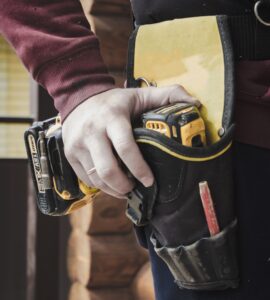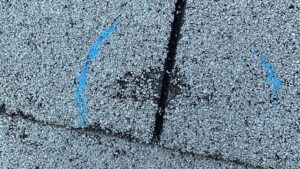If there’s one thing any roofing company in Minneapolis knows, it’s how to install a roof on an ice house. However, you don’t need to hire a local roofing company for this type of job, with these steps you can do a roof installation on an ice house, or other small structure by yourself.
Not all roof installation projects require you to call a local roping company to do the job, some small, closer to the ground jobs are perfectly safe for homeowners to DIY, like a roof installation on a dog house, tool shed, or ice house.
Inspect the roof of your ice house or tool shed
You can skip this step if you are working on a new structure that does not have a roof built yet.
Before you start, be aware of what you’re getting into. Here are some things to consider.
The ice house roof either has one sloping side or multiple planes that meet in a peak. Ridge cap shingles are required to cover roof peaks, so add them to your shopping list.
Do you plan to reshingle the ice house? If so, it will be necessary to start by removing the old shingles. This necessitates an additional step and more tools.
The roof may have sustained damage from age or a hail storm. Before shingling the roof, the sheathing must be in good condition. Replace any areas that have holes, cracks, or other damage indicators.
Measure the ice house, then measure again
Before making any purchases, measure the tice house’s roof’s length and width. And take two measurements of everything!
Next, determine how many square feet the roofing plane or planes of the ice house are. You will only have one plane if the roof has a mono-pitched or single-slope configuration.
Now that you have an idea of how much roofing material the roof will require.
Sales of roofing materials, including shingles, are made in squares. A square of shingles, for instance, covers 100 square feet. Knowing your total square footage will help you decide how much material to buy.
Roofing calculator to help calculate with your ice house roof pitch.
Materials you’ll need:
Equipment and tools for roofing:
- Safety Glasses and good work gloves
- Hammer
- Nail Gun and staple gun
- Chalk or white grease pen
- Sheet Metal Snips
- Ladder
- Utility blade
- Rafter Square
- Long Measuring tape
- Multiple tarps
- Magnet for nail clean up
Roofing supplies
- plywood to support roof
- Sheathing for roofs
- Staples Nails Galvanized steel nails measuring 1 1/4″
- Drip edge
- roofing felt, underlayment
- Sealant
Optional Materials
- Roof rake or pitchfork (to remove old roof)
- Shingles for the ice house’s apex’s ridge
- Gutters and downspouts (optional)
Stage 4: Get ready
Trim back the grass close to the ice house. Rake the grass trimmings away after cutting the grass short. Although this is optional, it will help you see any nails and other debris that may fall during the roof installation.
Tarp the structure and area around it. Cleaning up might be simpler as a result.
Set a ladder (review this ladder safety blog) next to the ice house.
Lay out your supplies and equipment on the tarp.
Make sure safety gear fits properly.
Remove any outdated shingles and look for damage in step five.
Use a pitchfork, roofing rake, or roofing spade to remove old shingles.
Pry a row of shingles free from the sheathing by sliding the tool underneath them.
Pull out any remaining nails or staples after you have taken off all the shingles.
Check the roof for defects. Go to step 7 if you spot any.
Stage 6: Repair Damaged Sheathing
In order to remove damaged areas, use a circular saw.
Cut away enough damage to get to a rafter’s center.
Replace the plywood sheathing over the holes.
*Always wear safety glasses when using a circular saw! * Nail the sheathing to the exposed rafters of the ice house.
Install Drip Edge at Stage 7
A metal drip edge should be cut to the same length as the bottom edge of the roof.
Cut off that portion with some tin snips.
Put the drip edge up against the bottom edge of the roof.
Nail it down, leaving about 12″ between each nail.
Apply the same technique to the roof’s sides.
Apply drip edge to the top edge of a mono-pitched roof before shingling it.
Stage 8: Glue the plywood sheathing to the felt underlayment.
Over the surface of the sheathing, roll the felt underlayment.
Use a nail gun to staple the underlayment into position.
Stage 9: Draw chalk lines across the underlayment and up it.
Mark the roof first with horizontal lines as follows:
Mark the areas where the shingles should go with chalk or a pencil and a tape measure.
Mark the underlayment 12 inches from the bottom edge on one side, then mark the ice house’s remaining height in 5-inch segments.
On the opposite side of the underlayment, make the same marks, then draw lines connecting them.
Draw vertical lines now across the roof:
At the top and bottom edges of the roof, mark the center and then draw a line through the marks.
Vertical lines should be measured and marked at 6-inch intervals on either side.
Stage 10: Roof Shingles
From the bottom to the top, shingle the roof using a cutting and nailing method.
Place the shingles along the lines, cut them to size, and nail them to the roof to shingle it.
Place the first shingle down on the underlayment, parallel to the lowest horizontal line, and about one-half inch overhanging an edge.
Trim the shingle with a utility knife, following the direction of the closest vertical chalk line.
Fix it with a nail.
Stage 10.1: Finish the surface of the roof by adding starter shingles along the bottom edge.
You can either modify regular shingles to serve as a starter row or use a ready-made starter shingle.
Employ 3-inch nails.
Modifications to three-tab shingles:
By chopping off a shingle’s tabs, you can make starter shingles.
Place the shingles so that the glue strip is over the drip edge, 14 inch above the bottom of the roof, and 12 inch from the side of the roof.
The tab side should have an upward angle so that it faces the roof’s peak.
The shingles should be pushed down, any adhesive removed, and then nailed into place.
Repeat along the entire edge after chopping the tabs off another shingle.
Use starter shingles as follows:
Cut a 4″ starter shingle piece.
Place it flush along the edge, with a 14-inch overhang on the drip edge and a 12-inch overhang on the side.
Remove any adhesive backing, apply pressure, and then hammer a nail through it.
Nail it four times: in the middle, one inch from the edge, and one inch above the sealant strip.
This procedure should be repeated along the bottom edge or edges.
Shingle the roof in Stage 10.2
Apply shingles in a row over the starter row.
A section of shingles should be placed on top of the starter row, overlapping both the starter row and the tabs above it. 5 inches should be exposed.
Next, take off any adhesive, lay the shingle down, and secure it with nails.
Without going over the sides or overlapping the shingles, proceed along the row.
Over it, place a further row of shingles. Where the seams are, place these shingles in an uneven pattern. Two rows of shingles shouldn’t have seams in the same spot.
In the same manner, shingle the roof up.
The entire roof is shingled. When shingling a ice house roof, start at the very end. If not, make room for the ridge cap shingles. Stack shingles that are too high.
11.1: Finish top edge of Roof
Finish the Top Edge of a Mono-Pitchched or Single Slope Roof.
Row ice house Strip The last complete row of shingles that will fit on the roof without any adhesive seal hanging over the edge should be laid down.
If necessary, trim the shingles so that they are flush with the roof’s top edge.
Cut shingles into strips wide enough to cover the nails in the row below it, when positioned perpendicular to them, in order to prepare the final finishing row.
With the adhesive strip pointing up toward the top edge, place the first strip of shingles on the ground. It should cover any exposed nails on the row below it, be flush with one side, and overhang the edge by approximately 1 12″.
Lay the second shingle strip down so that it overlaps the first strip, then continue in this manner until the end.
With two nails in the adhesive and two in each corner, place the final strip on the floor.
Apply bitumen-based roofing cement to each nail head.
To be flush with the other shingles, trim the final strip’s top and sides.
Along the top edge, coat the exposed shingles with roofing cement.
Strip Cap Technique
For the final row, slice the shingles into strips. As a guide, consider the slots on a three-tab shingle.
To install the shingles, bend the tabs over the ridge and secure them with nails to create a cap.
On the final strip of shingles, tape the nails.
Finish a lean-to ice house in Stage 11.2.
Immediately up to the top edge, place the shingles.
Trim the final row if necessary to make it fit flush.
Over the row, along the top edge, place the final course of shingles.
Cover any exposed nails in the final row with overlap and stagger.
Apply roofing cement to any remaining exposed nail heads.
Use thermoplastic sealant to fill the space between the top edge of the shingles and the neighboring building.
Finish an Apex Roof ice house in Stage 11.3.
You can cut and bend regular shingles to finish an ice house roof with an apex or peak (see instructions above), or you can use ridge cap shingles to complete the roof.
Lay down the regular shingles up until the adhesive area begins to protrude beyond the edge.
Cut the shingles that hang over the edge.
Place the first ridge cap shingle so that the adhesive section faces the roof and the asphalt section points outward toward the edge.
To fasten the first ridge cap shingle, drive a nail through the adhesive portion of the shingle.
Start from one end and follow the same path until you reach the center.
When you reach the center, fit the final shingle in place by, if necessary, trimming some of the adhesive portion off.
The center of the two middle shingles’ exposed adhesive should be covered by the final ridge cap shingle.
At each corner, fasten the final shingle with four nails.
Roofing cement is used to cover the nails.
12th stage: cleanup
The materials should be taken out of the tarp and stored.
To clear the roof of debris, use a leaf blower. Or very gently sweep the roof.
Take the tarp off.
Visually inspect the ground and remove any trash, staples, or nails.
To remove any additional nails, utilize a magnetic nail sweeper.
You can get a properly shingled ice house, doghouse, lean-to, or ice house by following these instructions. The structure will be more resilient to the elements, stronger, and more appealing.
Take your time, prioritize safety, and don’t hesitate to contact a local roofing company whenever you need help with your roofing.





